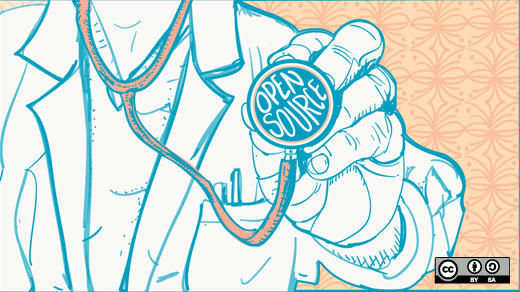Open source software in healthcare has been instrumental for sharing common tools and increasing adoption of emerging medical information technology (IT) standards. By leading the effort to digitize health data, imaging informatics has set the precedent for the adoption of the technology industry's best practices and subsequently open source software.
The domain of imaging informatics is generally associated with radiology, though other specialties such as cardiology, pathology, and dermatology are also heavily based on medical imaging. Radiology involves both sophisticated medical hardware and software. The "modalities," such as Computed Tomography (CT), Magnetic Resonance Imaging (MRI) and Computed Radiography (CR/DR, otherwise known as X-Ray), produce images that are interpreted by radiologists. Radiologists are medical doctors with specialized training in imaging, who often use software tools with advanced postprocessing and computer vision functionality to interpret the images.
The storage and presentation of medical images was one of the first initial challenges in imaging informatics; a typical CT scan today produces thousands of images, which require storage space of ~500MB. A 1000-bed hospital may have more than 1300 radiology examinations done in a single day with an average of 350+ images, and these images need to be stored for at least seven years (different rules apply for pediatrics and mammography) due to Health Insurance Portability and Accountability Act (HIPAA) regulations. Medical images contain several thousand shades of gray and require a higher bit-depth than traditional commercial imaging formats. Picture Archiving and Communication Systems (PACS) emerged to tackle the management of these images; these systems are responsible for storage, retrieval, transmission and display of medical images.
The first generation of PACS technology was created in the late 1980s by modality vendors, who implemented proprietary file and representation formats and bundled the PACS as part of a modality purchase. Integration and interoperability quickly became the next challenge as having a centralized archive of all medical images was not easily attainable and the visualization of medical images could not be separated from the archiving functionality. The National Electronic Manufacturers Association (NEMA) developed means to standardize the storage, transmission and presentation of medical images through a standard named Digital Imaging and Communications in Medicine (DICOM).
Open source development has been critical in the adoption of DICOM as the de facto global IT standard for medical imaging. The Radiological Society of Northern America (RSNA) commissioned two groups to develop the first reference implementations of DICOM in the early 1990s as a means to accelerate the adoption of the standard. The OFFIS group from Oldenburg, Germany, developed DCMTK—a collection of libraries and applications implementing large parts of the DICOM standard, which includes software for analyzing, constructing, converting DICOM image files, handling offline media, sending and receiving images over a network among many others. The Electronic Radiology Lab at the Mallinckrodt Institute of Radiology from St. Louis, MO developed the Central Test Node (CTN, https://erl.wustl.edu/research/dicom/ctn.html) software to support cooperative demonstrations by medical imaging vendors. Both of these open source projects, along with other successful open source projects such as DCM4CHE and DVTK are widely considered to be part of a PACS administrator’s essential toolkit to carry out their daily tasks.
The other domains of Imaging Informatics mainly include the transmission of medical data between systems and managing the workflow of a radiologist. The typical workflow of a radiology exam begins when another physician orders an imaging examination for a patient. After scheduling, a technologist then carries out the examination in the appropriate modality. These examinations go into work queues of radiologists, otherwise known as worklists. A radiologist may interpret upwards of 150 cases a day, reviewing the images for each and generating a textual report. This requires that these exam orders be managed in worklists sorted by the various types of examinations, and that the results—the radiology reports—be transmitted to other information systems such as an Electronic Medical Record (EMR) in an automated fashion. A Radiology Information System (RIS) is responsible for such functionality among many others such as scheduling the patients’ exams and providing medical information about the patient to be used as part of the medical images. A RIS uses the Health Level 7 (HL7) standard to communicate with other systems. A RIS or a PACS Administrator may use an open source tool such as Mirth Connect to develop, test, deploy, and monitor HL7 interfaces. There are open source APIs, such as HAPI for parsing HL7 information in an objective manner.
There are other popular open source projects for image viewing and processing:
These open source projects represent just a handful of all the open source projects used in imaging informatics, let alone healthcare. The communities that support these projects are strong and growing more than ever. Many of the projects mentioned above can be seen at Open Source Plug Fest, hosted every year to promote knowledge and sharing of open source projects in imaging informatics by The Society of Imaging Informatics in Medicine (SIIM). There, the direction of a projects are discussed with colleagues and the most successful project of the year is elected.
This year, SIIM 2014 welcomes healthcare open source projects from other domains to participate in its 7th Annual Open Source Plug Fest from May 15 - 17 in Long Beach, California. Register by February 28. Another event that may interest developers is the 1st annual Hackathon where you can learn about using the latest web-based healthcare APIs.
Written with: Don K. Dennison, Tessa Cook, MD, PhD, Paul Nagy, PhD, FSIIM






4 Comments